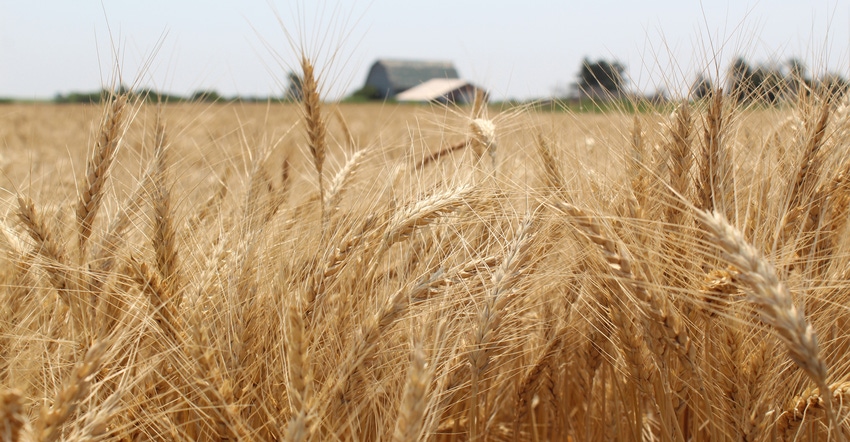
There’s always going to be challenges to growing wheat — from weather that’s too wet or too dry, to increased disease and pest pressures, farmers have a lot of factors to juggle every year. And 2021 was no exception.
The National Wheat Foundation’s 2021 National Wheat Yield Contest results show that farmers are learning how to reach the genetic potential of today’s wheat varieties with crop input and management decisions that bring the best to the bin.
“This year has presented many diverse challenges to farmers,” says David Cleavinger, National Wheat Foundation board chairman, in a release. “Drought has plagued most spring wheat growers, and many winter wheat farmers faced the exact opposite — fighting a wet harvest in multiple areas. These challenges have not only shown the persistence of growers in this industry, but also have highlighted the diversity of wheat which is shown in the range of yields of each region.”
Around the nation, the NWF reports that crops in spring wheat country, to the north, saw historic drought and a heat wave that is described as a 1,000-year weather event. Farmers in winter wheat country, to the south, dealt with a February historic winter outbreak of snow, sleet, freezing rain and extreme cold that lasted for several days right as the crop was breaking dormancy. To the northeast, excessive rains bogged down harvest.
Justin Gilpin, CEO of Kansas Wheat, said farmers participating in the contest this year showed that management tools and practices can not only help wheat weather the challenges of drought and freezing temperatures, but then also take advantage of a cooler and wetter spring at grain fill. And when prices started to rebound, it was a signal to many growers to push their wheat crop even further.
“Those who put in the management and investment with fertilizer and nutrients, but who also managed disease with genetics and foliar fungicides, we saw the end result,” Gilpin says. “That shows the capabilities of the varieties are that are out there, and the farmers who are using good practices.”
Categories
Wheat growers from 20 states competed this year in two primary categories, winter wheat and spring wheat. Those categories are further divided into dryland and irrigated wheat. And there are also two levels of awards given, based on yield, and the percentage increase of yield compared to the county average. As NWF says, the percentage category is meant to level the playing field for those growers producing wheat in low-yielding regions, and only in dryland categories.
According to NWF, the entries must be Grade 1 or 2 by Federal Grain Inspection Service standards to be eligible for awards. The goal of the contest is to recognize high yields as well as added quality to the crop, which is what millers and bakers count on from U.S. wheat.
Winter wheat
In the winter wheat categories, at the national level, farmers to the north once again dominated the dryland and irrigated yield categories.
William Willard, Montgomery County, Md., walked away with the top Bin Buster award for his winter wheat-dryland entry of Pioneer 26R59 variety that yielded 141.41 bushels per acre. Also placing in the category were:
• First, Jeffery Krohn, Michigan. Dyna-Gro 9242, 140.54 bushels per acre
• Second, Brian Kreider, Pennsylvania. Pioneer 25R74, 140.42 bushels per acre
• Third, Douglas Goyings, Ohio. Strike 403, 138.26 bushels per acre
• Fourth, Michael Ebelhar, Kentucky. AgriMAXX 505, 126.07 bushels per acre
• Fifth, Tyler Ediger, Kansas. WestBred WB4792, 125.66 bushels per acre
In the winter wheat-dryland percentage increase category, Travis Freeburg of Kimball County, Neb., took first place with his Plains Gold Langin variety that yielded 108.29 bushels per acre. Other winners who improved compared to their county five-year Olympic averages included:
• Second, Shawn Kimbrell, Texas. WestBred WB4595, 50.89 bushels per acre
• Third, Zach Balahtsis, Oklahoma. Limagrain LCS Helix AX, 101.21 bushels per acre
• Fourth, Kenneth O’Neal, Texas. WestBred, WB4792, 76.54 bushels per acre
• Fifth, Matt Jaeger, Kansas. WestBred WB4792, 122.47 bushels per acre
In the winter wheat-irrigated category, Steven VanGrunsven, Washington County, Ore., took Bin Buster honors with his Limagrain LCS Shine entry that yielded 192.73 bushels per acre. Placing first was Rylee Reynolds, Idaho, with Syngenta SY Ovation, yielding 190.05 bushels per acre. In second was Joel Zwainz, Washington, with Limarain LCS Shine, yielding 182.17 bushels per acre.
Looking ahead
Gilpin says farmers should look at the management practices coming out of the contest for inspiration, as they look ahead to the 2022 crop to really get a handle on their input costs and take advantage of higher prices.
“Minneapolis spring wheat is at 10-year highs because of drought in the Dakotas and Canada, and that’s been one of the first catalysts that helped spur the wheat market on,” he says. “Global supplies are in decline. U.S. stocks are at 14-year lows. All of those combined with the uncertainty of the production going into the ground now has led to prices that we haven’t seen in over 10 years.
“Unfortunately, we have seen input prices that we haven’t seen since then, too,” Gilpin adds. Farmers are seeing rising input costs due to supply chain disruptions overseas, with some farmers seeing the price of contracted inputs increasing three to four times of their old contracts.
This environment is why the Kansas Wheat Commission has funded research at Kansas State University with Romulo Lollato, Extension wheat specialist, to create the Wheat Rx Program for farmers in the Southern Plains, Gilpin says. It combines not only management tips for increased yields, but also higher-quality wheat, and how to achieve that without breaking the bank on input costs.
To see more results from the National Wheat Yield Contest, visit wheatfoundation.org.
About the Author(s)
You May Also Like






